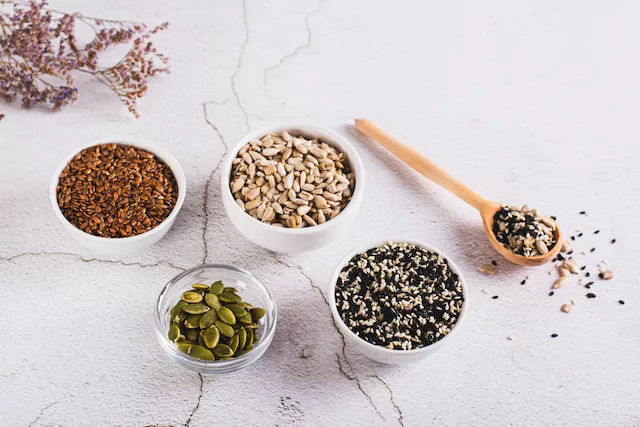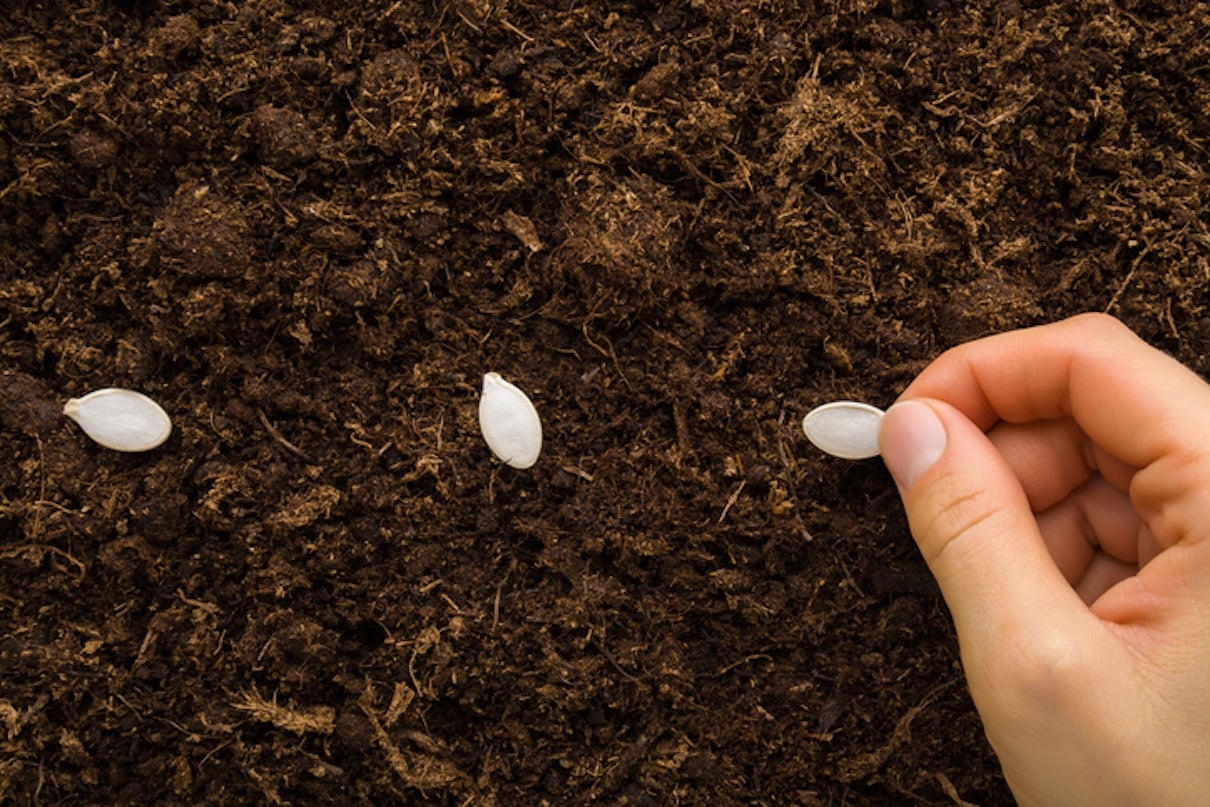Table of Contents
Many health and wellness trends have become wildly popular in the last few years, focusing on specific aspects of health to create a whole sense of well-being. While not a new concept, seed cycling has become one of these popular trends among those with hormone issues (and for a good reason, too). Taking up seed cycling has the ability, over time, to naturally balance the hormones in our body and alleviate related symptoms, including PMS, irregular periods, fertility issues, gut health, and more.
“I love seed cycling as a concept and a way for women to engage in their own care and support harmony in their systems,” says naturopath doctor and owner of Meridian Medicine, Mona Fahoum, ND. “There is [almost] no research on seed cycling, but from a traditional medicine perspective and nutrition perspective of the seeds we use, it weaves in very nicely to support the whole system with the right energetics and nutrition in each phase of the cycle.”
What Causes a Hormonal Imbalance?
Hormones play a crucial role in regulating our day-to-day body function, influencing everything from our metabolism to mood. However, factors such as stress, poor diet, lack of exercise, sleep, and environmental toxins can contribute to a hormonal imbalance. Experiencing an imbalance can cause a variety of issues, impacting our menstrual cycles, fertility, skin health, and mental health.
One of the primary reasons for hormonal imbalance in women is the disruption of estrogen and progesterone levels. Having too much estrogen in the body can lead to irregular menstrual cycles, mood swings, and even conditions like polycystic ovary syndrome (PCOS). On the other hand, low estrogen and progesterone levels can result in symptoms like fatigue, low libido, depression, and difficulty concentrating.
For a more balanced hormone routine, incorporate HUM’s Hormone Balance.

What is Seed Cycling and How Does It Work?
Seed cycling is a holistic and natural approach to restoring hormonal balance. The process of seed cycling involves incorporating seeds into your diet during the two main phases of your menstrual cycle (follicular and luteal) to balance and support healthy estrogen and progesterone levels. “Seed cycling allows us to increase some of the phytonutrients, oils, vitamins, and minerals that can support the phases of our cycle,” Fahoum says.
There are four seeds that are consumed during seed cycling:
Pumpkin Seeds: Pumpkin seeds are rich in omega-3 fatty acids, magnesium, and zinc, which help balance estrogen and progesterone levels. They also contain phytoestrogen, a polyphenol compound that exerts an estrogen-like effect on the body.
Flax Seeds: Flax is also rich in omega-3 fatty acids and can boost fertility and estrogen production. Additionally, flax seeds contain a high amount of a plant compound called lignans, a type of phytoestrogen (or plant compound) that mimics the structure of estrogen.
Sesame Seeds: Like flax seeds, sesame seeds also contain lignans, along with calcium, fiber, iron, and zinc. Consuming these seeds helps boost (and balance) progesterone production while preventing excess estrogen from accumulating.
Sunflower Seeds: Sunflower seeds are rich in Vitamin E and selenium, which increase progesterone production and detox any extra estrogen your body may be making that you don’t need.
Before beginning the seed cycling process, understanding how the two main phases of your menstrual cycle works is fundamental to achieve a healthy balance.
Follicular Phase
The follicular phase begins on the first day of menstruation and lasts until ovulation (14 days). During this phase, it’s recommended that you consume two tablespoons of flaxseeds and pumpkin seeds each day. Using the two seeds helps estrogen levels rise during the follicular phase, peaking just before ovulation and resulting in a healthy hormonal balance. Fahoum says, “Using ground flax, for example, in the follicular phase (Days 1-14) supports mitigating any excess estrogen in the system since a good quality flax is high in lignans. That phytonutrient is a natural phytoestrogen, so it helps either lower excess estrogen (often the case in PMS) or raise low estrogen (like in menopause) –it’s a balancer.”
Luteal Phase
The luteal phase occurs after ovulation and continues until the start of the next menstrual cycle (14 days). During this phase, two tablespoons of sesame and sunflower seeds are consumed daily, providing the necessary nutrients to support progesterone production. Progesterone is the dominant hormone during this phase; sunflower and sesame seeds help progesterone levels rise while slowly lowering your estrogen levels, balancing both hormones. Zinc, for example, which is largely found in sesame seeds, Fahoum says, “has been shown to concentrate and support the corpus luteum, which is responsible for progesterone production in the luteal phase.”
How Does Seed Cycling Benefit the Body?
While scientific evidence regarding seed cycling is almost non-existent, a recent study found that using seeds to treat polycystic ovary syndrome (PCOS) may prove the concept works. The study examined 90 women with PCOS, between ages 15 and 40 years old, for 12 weeks and divided them into three groups:
- The first group was a control group.
- The second group was an experimental group that treated the women with a portion-control diet and a 500mg dose of Metformin daily.
- The third group was also an experimental group that treated the women with a combination of a portion-control diet and seed cycling.
After 12 weeks, results showed that the highest follicle-stimulating hormone (FSH) levels were found in the control group, followed by the second group, with the seed cycling group showing the lowest levels (a 1.2%-2.5% decrease). As for the Luteinizing hormone (LH), levels in the control group showed an increase, while both experimental groups showed a decline. Specifically, the seed cycling group showed a decrease of 1.5%-2%. Overall, the study concluded that incorporating seed cycling into a woman’s diet can help treat PCOS.
Here are other benefits of incorporating seed cycling:
1. Balancing Hormones Naturally
The main benefit of seed cycling is its ability to naturally balance estrogen and progesterone levels within the body. The specific nutrients found in these four seeds support the body’s natural hormone production, helping to restore any hormonal imbalances.
2. Menstrual Cycle Regularity
Seed cycling is often praised for its potential to regulate menstrual cycles. Synchronizing the recommended seed intake with the two main phases of your menstrual cycle increases the chance of having regular periods on a stable schedule. This regularity can, in turn, alleviate symptoms associated with irregular cycles, such as mood swings, bloating, and cramps.
3. Reduced PMS Symptoms
Those who suffer from premenstrual syndrome (PMS) can experience symptoms ranging from irritability to fatigue and even breast tenderness. The balanced hormonal support from seed cycling can reduce the severity of PMS symptoms, enhancing overall well-being during the menstrual cycle.
4. Improved Fertility
For those trying to conceive, hormonal balance is the foundation for a healthy conception. During the menstrual cycle, your body creates and releases an egg in preparation for fertilization. If the egg isn’t used, your uterine lining sheds, resulting in you getting your period. In addition to the benefits of having regular menstrual cycles with healthily balanced hormones, seed cycling can increase the chances of fertility and conception.
5. Enhanced Skin Health
Hormonal imbalances can often negatively affect the skin, contributing to conditions like acne and dryness. The hormone-balancing properties in seed cycling, such as Vitamin E, zinc, and omega-3 fatty acids, can promote a clearer complexion and a more radiant appearance.
How to Start Seed Cycling
Achieving positive results from seed cycling and balance hormones requires planning, consistency, and patience. This step-by-step guide will teach you how to incorporate seed cycling into your routine:
- Familiarize Yourself with Your Menstrual Cycle
Start by tracking your menstrual cycle to determine the length of your follicular and luteal phases. Doing this will help you properly sync seed cycling with your body’s natural rhythm.
- Stock up on Your Seeds
If you don’t already have them at home, make sure to purchase all of the seeds you will need. Choose high-quality flaxseeds, pumpkin seeds, sesame seeds, and sunflower seeds for the seed cycling process. (Pro Tip: Using ground flax seeds as an alternative to whole seeds can offer more nutritional benefits since they’re easier to digest.)
- Incorporate the Seeds into Your Diet
During the follicular phase (days 1 through 14), consume two tablespoons (each) of ground flaxseeds and pumpkin seeds daily. As you enter the luteal phase (days 14 through 28), consume two tablespoons each of sesame and sunflower seeds. You can incorporate the seeds into your daily meals by adding them to smoothies, salads, yogurt, or oatmeal.
- Be Patient and Consistent
Balancing your hormones to healthy levels doesn’t happen overnight; therefore, being patient and consistent with your seed cycling routine is essential. Fahoum states, “I always tell my patients — ‘We didn’t get here in one day, so we’re not going to resolve it tomorrow.’ Our cycles are about a month long and in order to get our hormones to harmonize again, our bodies literally have to clean out old instruments, build, fix and retune. I expect improvements to start occurring within the first couple cycles.”
- Monitor Your Results and Adjust as Necessary
Just as it’s important to be patient and consistent, it’s also necessary to regularly assess how your body responds to seed cycling. If you notice positive changes with the incorporation of the seeds, such as improved energy levels, regulated menstrual cycles, and reduced PMS symptoms, continue with the routine. If you experience adverse effects or see no results, consider seeing a naturopath physician to discuss specialized care.
Seed cycling provides a nutritional and holistic approach to hormonal balance, addressing the root causes of imbalances rather than masking the symptoms like many medications can. By incorporating specific seeds into your diet during different phases of your menstrual cycle, you can naturally support the production of estrogen and progesterone, leading to consistent menstrual cycles, reduced PMS symptoms, and enhanced overall well-being. While seed cycling is natural and generally safe for most individuals, it’s essential to consult with your healthcare provider before starting a new treatment, especially if you have any underlying health conditions or concerns.





More Stories
Avocado Cacao Mousse – JSHealth
Janelle Brown on Garrison’s Mental Health Before His Death
How To Finally Beat Insomnia